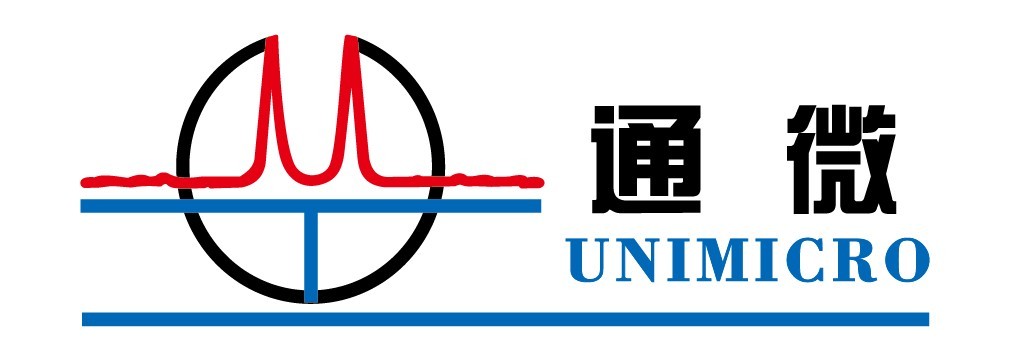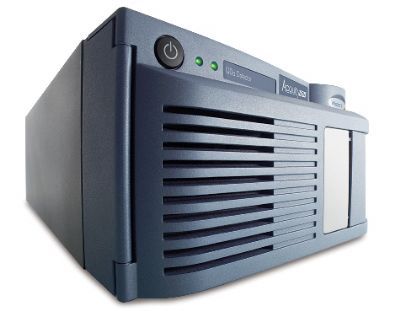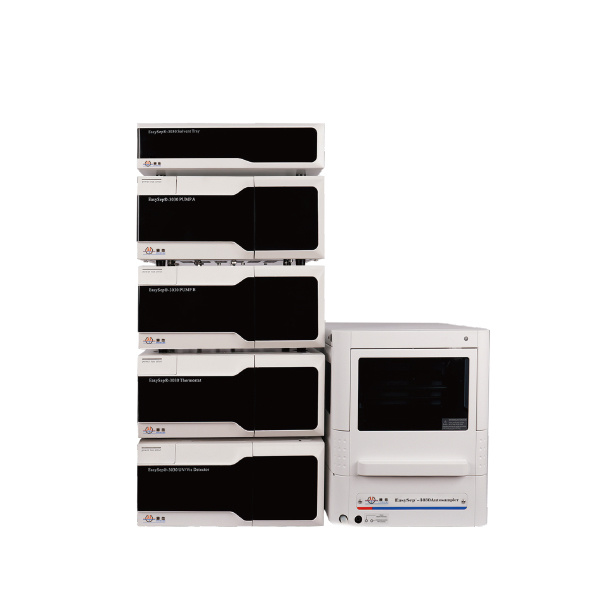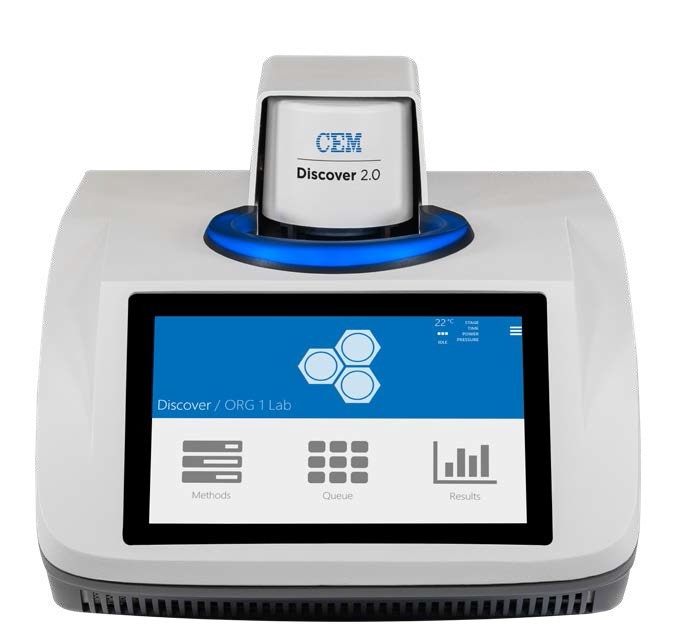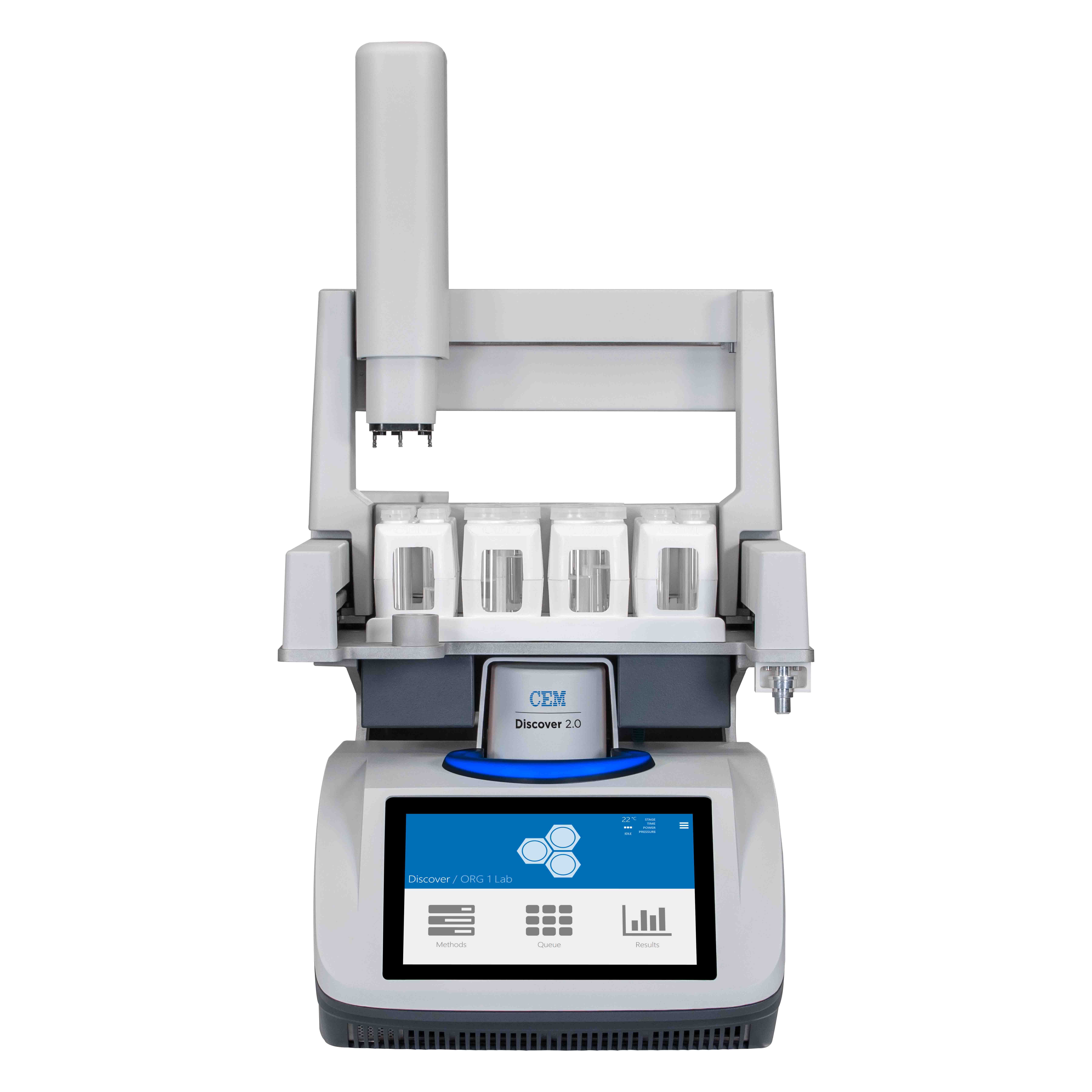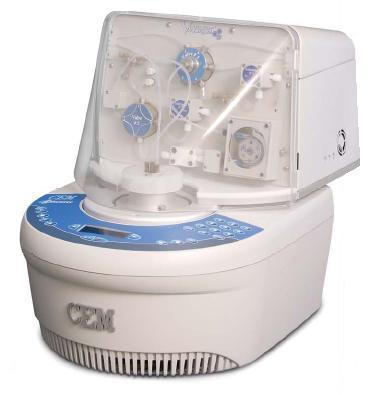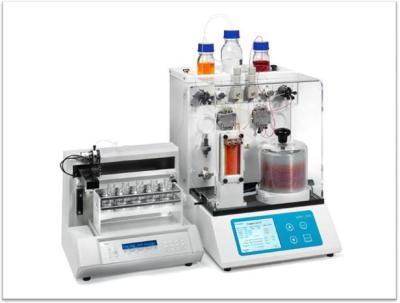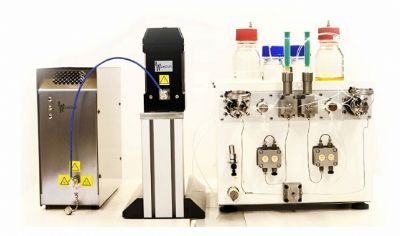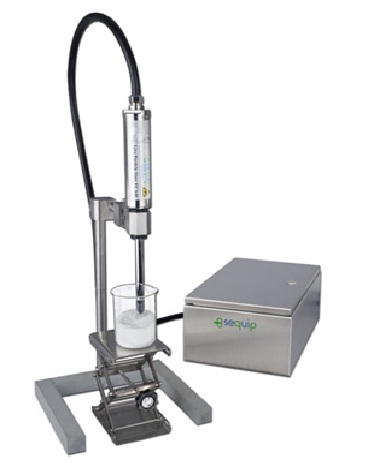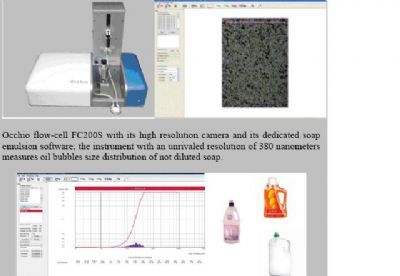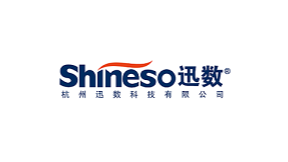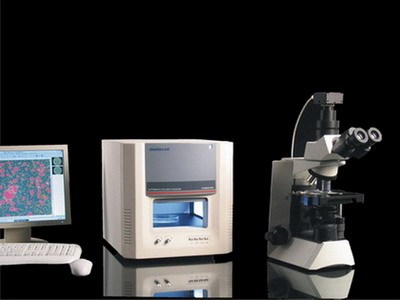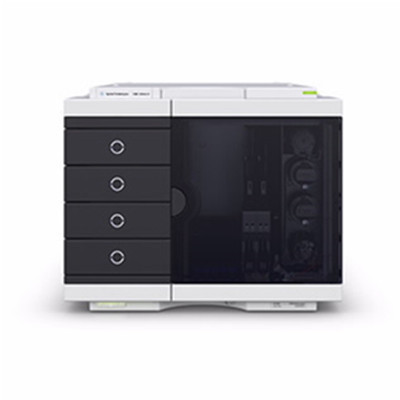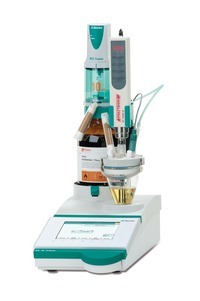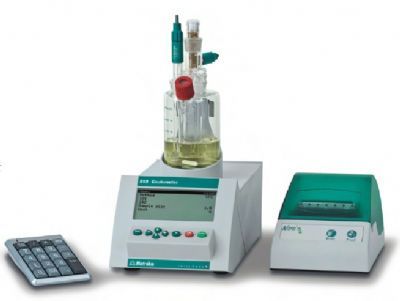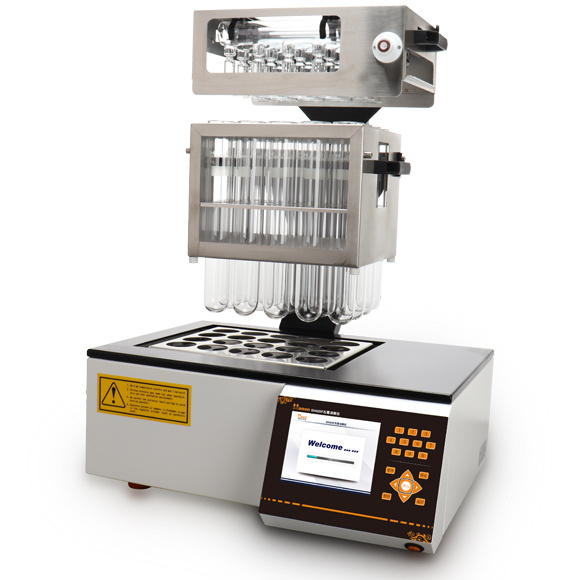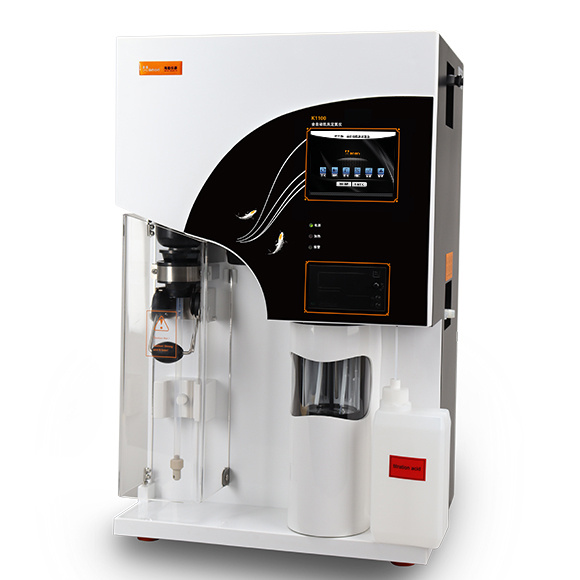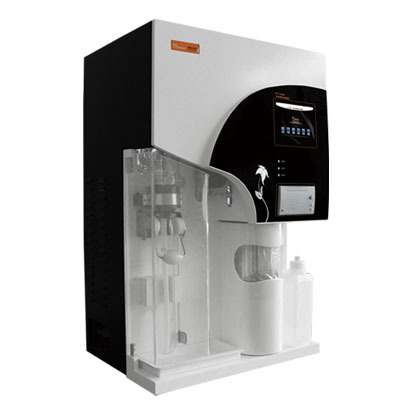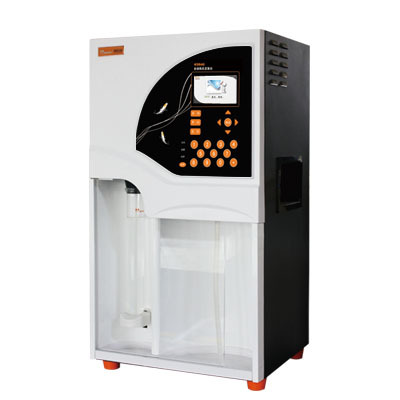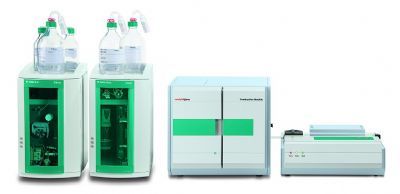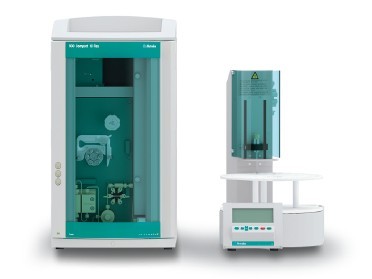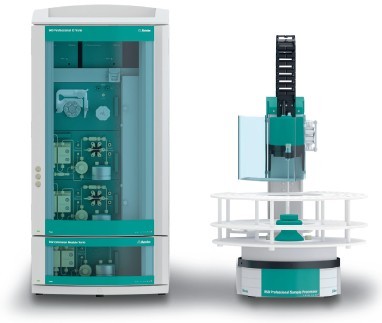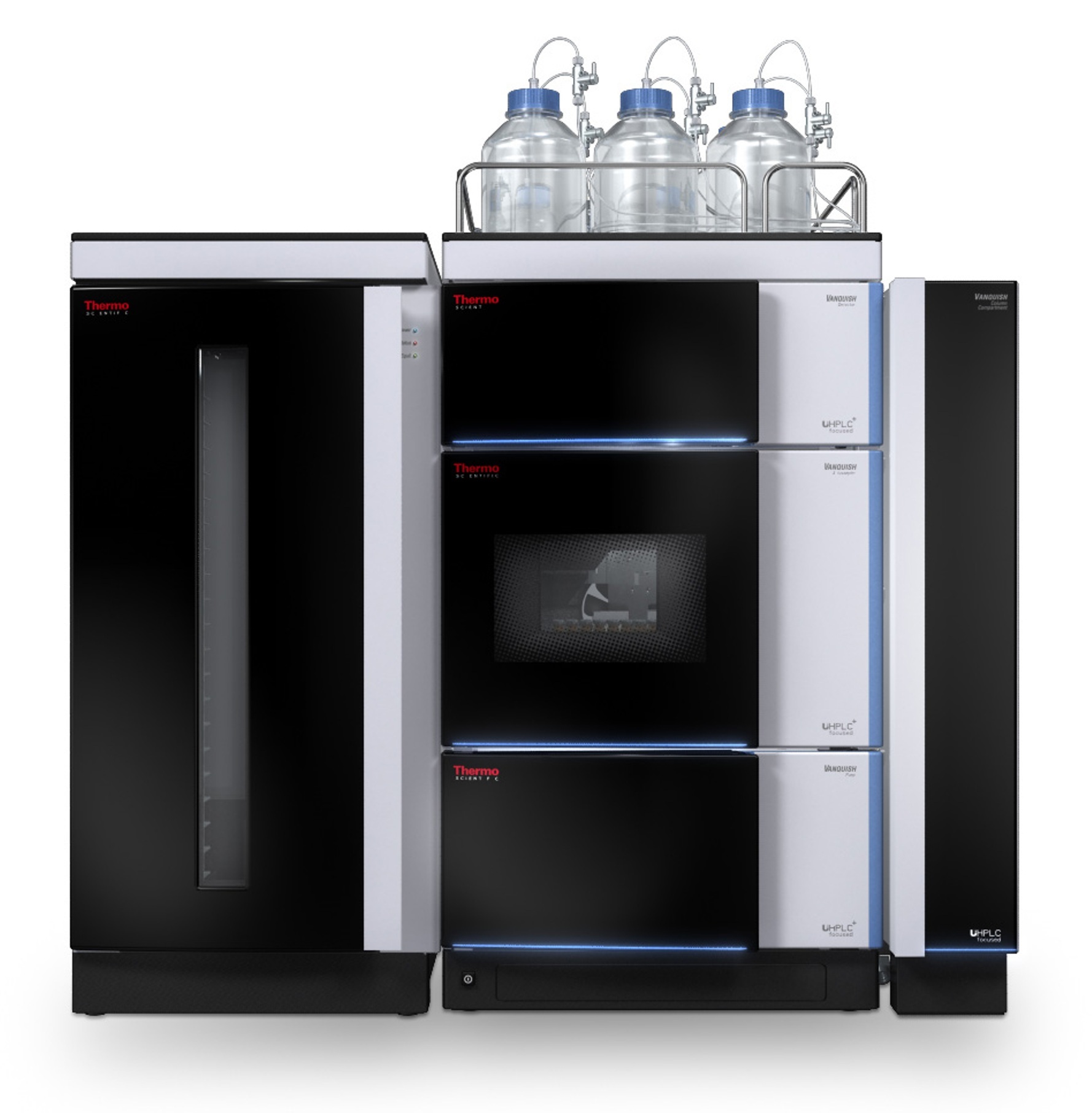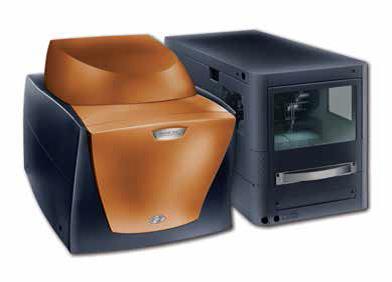药品中用高分辨TGA表征其结构水和自由水检测方案
The amount of moisture in pharmaceutical formulations is
an important quality control parameter because it can affect
their long-term stability and ultimate effectiveness as well
as short-term processability. Techniques such as Karl
Fischer titration, moisture evolution analysis (1,2), and
thermogravimetric analysis (TGA) have been used for
determining pharmaceutical moisture levels. However,
these techniques often have trouble differentiating
between “free” surface water (the source of problems) and
bound water present in the chemical formulation.
检测样品:
化药新药研发
检测项:
其他
TA仪器
查看联系电话
前往展位
碱性药物中毛细管电色谱分析检测方案
本研究应用毛细管电色谱(CEC)使用商业化的硅胶固定相和含水流动相
分离一系列的碱性药物。流动相的组成、缓冲液的PH值、电压、缓冲液的负
离子对这些碱性药物的保留时间的影响都进行了研究。在PH为7. 8时,得到
了理想的图谱,但是发现重现性极差。然而,在PH为2. 3时,获得了这些碱
性药物的良好的、可重现的图谱。
我们先前证明了低的PH值下,使用反相填充材料,在流动相中加入添加
剂诸如磷酸三乙醇胺可得到极好的CEC分析碱性药物的效果。在相同的条件
下,使用硅胶固定相分离这些药物,是为了改善峰的形状,获得了极好的如
苄胺、去甲替林和苯海拉明等碱性药物的图谱。
实验显示了用CEC分离碱性药物能很容易地获得极好的峰形和高达3.2万
理论塔板数/米。
检测样品:
化药新药研发
检测项:
其他
上海通微分析技术有限公司
查看联系电话
前往展位
化学药中有效成分含量分析检测方案
使用单一检测技术进行方法开发是一项比较困难的挑战,UV谱图数据有助于进行峰纯度评估和鉴定,但如果存在共流出物,峰追踪就难以实现。质谱数据可针对少数化合物实现色谱峰匹配,但如果存在同量异位化合物,就需要更多信息才能进行谱峰确证:无论是想要立即获取UV鉴定结果还是更可靠的分析定量,完整的分离都是最基本的要求。
为应对这些挑战,可以使用多种检测器来对单个样品进行分析,每种检测技术分别针对不同理化特性的分子。将检测器响应整合到一个软件界面中,就可以通过精简的平台简化数据分析
检测样品:
化药新药研发
检测项:
其他
沃特世科技(上海)有限公司(Waters)
查看联系电话
前往展位
化学药中主要物质含量分析检测方案
Previously it has been shown that glycerol can be regioselectively glucosylated by sucrose phosphorylase from Leuconostoc mesenteroides to form 2-O--d-glucopyranosyl glycerol.A series of compounds related to glycerol were investigated by us to determine the scope of the -glucosylation reaction of sucrose phosphorylase. Both sucrose
and glucose 1-phosphate (G1P) were applied as glucosyl donor. Mono-alcohols were not accepted as substrates but several 1,2-diols were readily glucosylated, proving that the vicinal diol unit is crucial for activity. The smallest substrate that was accepted for glucosylation appeared to be ethylene glycol,which was converted to the monoglucoside for 69%. Using high acceptor and donor concentrations (up to 2.5 M), sucrose or G1P hydrolysis (with H2O being the ‘acceptor’) can be minimised. In the study cited above, a preference for glucosylation of glycerol on the 2-position has been observed. For 1,2-propanediol however, the regiochemistry appeared to be dependent on the configuration of the substrate. The (R)-enantiomer was preferentialy glucosylated on its 1-position (ratio 2.5:1), whereas the 2-glucoside is the major product for (S)-1,2-propanediol (1:4.1). d.e.ps of 71–83% were observed with a preference for the (S)-enantiomer of the glucosides of 1,2-propanediol and 1,2-butanediol and the (R)-enantiomer of the glucoside of 3-methoxy-1,2-propanediol. This is the first example of stereoselective glucosylation of a non-natural substrate by sucrose phosphorylase. 3-Amino-1,2-propanediol, 3-chloro-1,2-propanediol, 1-thioglycerol and glyceraldehyde were not accepted as substrates.
检测样品:
化药新药研发
检测项:
其他
上海鑫欣生物科技有限公司
查看联系电话
前往展位
化学药中主要物质含量分析检测方案
A biomimetic approach has been investigated and developed for the total synthesis of azonazine, an unusual marine natural cyclopeptide containing a rigid transannular 10-membered ring. A hypervalent iodine-mediated direct oxidative cyclization was successfully developed and applied to construct the highly strained core, which was the key step in the first total synthesis of ent-()-azonazine. Based on the physical evidences of synthesized diastereomer and enantiomer of azonazine, both the relative and absolute configurations of the natural product were revised. Two fluorinated azonazine derivatives were also synthesized in short convenient steps utilizing the same intermediate in this work. The established total synthesis opens a potential opportunity to study the structureeactivity relationship of natural azonazine.
检测样品:
化药新药研发
检测项:
其他
上海鑫欣生物科技有限公司
查看联系电话
前往展位
小鼠大脑皮层中细胞研究检测方案
目的:探讨丙戊酸镁对小鼠急性脑缺血再灌注损伤的预防作用及其机制。
方法:取小鼠随机分为假手术组、模型组和丙戊酸镁高、低剂量(0.04、0.02 mg·g-1)组,每组10 只,灌胃给予相应药物,每日2 次,连续14 d,末次给药1 h 后对后3 组小鼠建立急性脑缺血再灌注损伤模型,建模成功后检测各组小鼠脑指数和脑组织中丙二醛(MDA)含量及超氧化物歧化酶(SOD)、谷胱甘肽过氧化物酶(GSH-Px)活性,并观察大脑皮层和海马CA1 区细胞形态的变化。
结果:与模型组比较,丙戊酸镁高、低剂量组小鼠神经元损伤减轻,脑指数和MDA含量明显降低,GSH-Px活性明显升高(P<0.01 或P<0.05),且丙戊酸镁高剂量组SOD活性明显升高(P<0.01)。结论:丙戊酸镁对小鼠急性脑缺血再灌注损伤具有预防作用,其机制可能与抗氧化作用有关。
检测样品:
化药新药研发
检测项:
其他
杭州迅数科技有限公司
查看联系电话
前往展位
b-受体阻滞剂中低 pH 和高 pH 条件下分离检测方案(液相色谱仪)
b-受体阻滞剂或b-肾上腺素受体阻滞剂是一类用于治疗高血压与控制心律失常的药物。b-肾上腺素受体拮抗剂可通过阻断肾上腺素及其他应激激素与神经末端的b-受体的结合而减少这些激素的影响。礼来实验室在1958 年合成出了第一种b-受体阻滞剂,但直到 1962 年才开发出首批具有临床意义的b-受体阻滞剂心得安和萘心定,并将其用于治疗心绞痛。
b-受体阻滞剂可阻断肾上腺素和去甲肾上腺素对尤其是b-肾上腺素受体的作用,而b-肾上腺素受体是调节“战斗或逃跑”反应的交感神经系统中的一部分。已知存在三种类型的b-受体,分别称为b1、b2 和b3 受体。b1-肾上腺素受体主要存在于心脏和肾脏中;b2-肾上腺素受体主要存在于肺、胃肠道、肝脏、子宫、血管平滑肌和骨骼肌中;b3-肾上腺素受体则存在于脂肪细胞中。
数量众多的b-受体阻滞剂根据其阻断b-受体的类型而分为不同种类,因此其作用也各不相同。心得安等非选择性b-受体阻滞剂能够阻断b1 和b2 受体,并对心脏、血管和呼吸道产生影响。美托洛尔等选择性b-受体阻滞剂主要阻断b1 受体,因此主要影响心脏而不影响呼吸道。而心得乐等某些b-受体阻滞剂则能够模拟肾上腺素和去甲肾上腺素的作用,并可导致血压和心率的升高。
采用填充2.7 μm 或4 μm 颗粒的Agilent Poroshell HPH C18 色谱柱在高pH 流动相下分析诸如b-受体阻滞剂等碱性化合物是一种常规方法。这些色谱柱填充表面多孔颗粒,可在方法开发中探索更宽的pH 范围。填充此类颗粒的色谱柱凭借其高效和快速的特点得到了越来越多的应用。
检测样品:
化药新药研发
检测项:
其他
安捷伦科技(中国)有限公司
查看联系电话
前往展位
化学药中有效成分含量分析检测方案
雷莫拉宁(Ramoplanin)是由游动放线菌(Actinoplanes spp) 发酵产生的一种口服抗生素,对好氧与厌氧的革兰氏阳性菌都有抗菌活性。分子结构的复杂性、无定形态以及缺乏常规的结晶过程使雷莫拉宁难以用差示扫描量热(DSC)分析进行鉴别。在水分和残余溶剂挥发之后,雷莫拉宁会发生分解,伴随产生一些气体产物。PerkinElmer的研究人员对雷莫拉宁的气体分解产物进行了鉴别分析。研究表明,雷莫拉宁在210 °C左右开始分解,释放出水蒸气、氯化氢、氨气、二氧化碳、一氧化碳,还有某种未知气体(可能是异氰酸)。PerkinElmer既可以提供热分析又可以提供红外光谱,能够比单一供应商提供更完整、全面地样品测试和表征。
检测样品:
化药新药研发
检测项:
其他
珀金埃尔默企业管理(上海)有限公司
查看联系电话
前往展位
化学药中特殊物质和基团检测方案
本实验研究了以卵磷脂和卵磷脂/胆固醇为包材,采用薄膜分散-挤压法制备阿霉素纳米脂质体的工业过程及包封方法。采用三瓶装的保存方式,在临床使用前,利用ph梯度载药法制备注射液,较好地解决了脂质体药物的存放难题。稳定性研究证明本方法制备的脂质体各种质量指标都与国外同类产品一致。
所用仪器有卡式水分测定仪、液相色谱仪、ph计等。
如欲了解更多该产品信息,可来电咨询 021-61610135
---------------------------------------------------------------------------
上海纳锘仪器有限公司
地址:上海市莲花南路1388弄8号楼碧恒广场1503室[201108]
电话:021-60900829,60900830,61131031,61131051
传真:021-61131052
E-Mail:info@nano-instru.com
检测样品:
化药新药研发
检测项:
其他
上海纳锘实业有限公司
查看联系电话
前往展位
化学药中有效成分含量分析检测方案
唑来膦酸(zoledronic acid)是新型的双磷酸类药物,为一种特异性的作用于骨的二磷酸化合物。该结构与骨质中的羟膦灰石呈高亲和力,并能与钙(铁等金属离子结合,形成可溶性或不可溶性复合物)。唑来膦酸能抑制因破骨活性增加而导致的骨吸收,降低血清钙和尿液中的钙排泄量。
唑来膦酸的无机类杂质与药品临床使用的安全性密切相关,如果药品中存在的杂质未能通过有效的方法加以检出(控制,将给临床安全造成直接或潜在的危害。因此,制订合理(有效的药品杂质检测方法,控制药品中的杂质是一项非常重要的工作。研究中选取磷酸(亚磷酸两种在唑来膦酸药物生产过程中容易产生的杂质为研究对象。虽然有报道可以用高效液相色谱法在线火焰分光光度法(折光率法(质谱法(电感耦合等离子体法等检测技术分析唑来膦酸药物,但这些直接的检测技术也只是应用于少数特殊双膦酸类药物的含量测定,由于双膦酸类药物大多没有可直接应用紫外检测器检测的生色团,因此往往都需要进行衍生反应才能分析检测,过程繁琐,并且无法对其有关物质&磷酸(亚磷酸'进行研究。利用离子对色谱分离配以电导检测器,既解决了双膦酸类药物的保留问题,又解决了其检测问题,为该类药物提供了有效可靠的分析手段。
检测样品:
化药新药研发
检测项:
其他
瑞士万通中国有限公司
查看联系电话
前往展位
化学药中有效成分含量分析检测方案
本文介绍了马血清中速尿((呋塞米)的提取和检测
关于Supelco
美国Supelco公司成立于1966年,一直致力于色谱耗材的研究和生产,是色谱耗材的专业生产公司。超过40年在色谱和分析领域的技术经验,拥有多项专利技术,提供范围广泛的产品:气相色谱柱(包括手性柱)和配件、液相色谱柱(包括手性柱)和配件、固相萃取小柱和装置、固相微萃取手柄和萃取头、空气检测产品、分析标准品和样品瓶等。1993年,Supelco(上海:021-61415566-8209 北京:010-65688088-6812 广州:020-38840730-5001)正式加入美国Sigma-Aldrich公司,成为Sigma-Aldrich公司旗下分析业务的专业品牌。
检测样品:
化药新药研发
检测项:
其他
默克化工技术(上海)有限公司
查看联系电话
前往展位
化学药中有效成分含量分析检测方案
本文介绍了SPE和HPLC方法检测血清中的抗生素(磺胺类药物).
关于Supelco
美国Supelco公司成立于1966年,一直致力于色谱耗材的研究和生产,是色谱耗材的专业生产公司。超过40年在色谱和分析领域的技术经验,拥有多项专利技术,提供范围广泛的产品:气相色谱柱(包括手性柱)和配件、液相色谱柱(包括手性柱)和配件、固相萃取小柱和装置、固相微萃取手柄和萃取头、空气检测产品、分析标准品和样品瓶等。1993年,Supelco(上海:021-61415566-8209 北京:010-65688088-6812 广州:020-38840730-5001)正式加入美国Sigma-Aldrich公司,成为Sigma-Aldrich公司旗下分析业务的专业品牌。
检测样品:
化药新药研发
检测项:
其他
默克化工技术(上海)有限公司
查看联系电话
前往展位
化学药中有效成分含量分析检测方案
本文介绍了SPE和HPLC方法检测血清中的抗生素(头孢菌素类)药物。
关于Supelco
美国Supelco公司成立于1966年,一直致力于色谱耗材的研究和生产,是色谱耗材的专业生产公司。超过40年在色谱和分析领域的技术经验,拥有多项专利技术,提供范围广泛的产品:气相色谱柱(包括手性柱)和配件、液相色谱柱(包括手性柱)和配件、固相萃取小柱和装置、固相微萃取手柄和萃取头、空气检测产品、分析标准品和样品瓶等。1993年,Supelco(上海:021-61415566-8209 北京:010-65688088-6812 广州:020-38840730-5001)正式加入美国Sigma-Aldrich公司,成为Sigma-Aldrich公司旗下分析业务的专业品牌。
检测样品:
化药新药研发
检测项:
其他
默克化工技术(上海)有限公司
查看联系电话
前往展位
生物制品中理化常数检测方案
The development of monoclonal antibody (Mab) based drugs has
undergone considerable growth since the release of the first Mab in the mid-eighties. Intuitive biophysical tools that examine and quantify interactions and conformational dynamics are important in demonstrating and understanding local and global conformational changes.
The structure of antibodies as well as other macromolecules is related to its function and efficacy therefore control over these parameters is essential. The association of antigens to antibodies or of antibodies to delivery assemblies such as liposomes or gold nanoparticles can be
addressed by isothermal titration calorimetry (ITC) while the folding of antibodies can be assayed using differential scanning calorimetry (DSC). Both techniques offer the advantage of using native solutions and both instruments are offered by TA Instruments.
检测样品:
化药新药研发
检测项:
其他
TA仪器
查看联系电话
前往展位
化学药中有效成分含量分析检测方案
本文介绍了SupelMIP分子印记SPE小柱和LC-MS-MS方法监测尿样中的安非他明和其他相关药物。
关于Supelco
美国Supelco公司成立于1966年,一直致力于色谱耗材的研究和生产,是色谱耗材的专业生产公司。超过40年在色谱和分析领域的技术经验,拥有多项专利技术,提供范围广泛的产品:气相色谱柱(包括手性柱)和配件、液相色谱柱(包括手性柱)和配件、固相萃取小柱和装置、固相微萃取手柄和萃取头、空气检测产品、分析标准品和样品瓶等。1993年,Supelco(上海:021-61415566-8209 北京:010-65688088-6812 广州:020-38840730-5001)正式加入美国Sigma-Aldrich公司,成为Sigma-Aldrich公司旗下分析业务的专业品牌。
检测样品:
化药新药研发
检测项:
其他
默克化工技术(上海)有限公司
查看联系电话
前往展位
化学药中有效成分含量分析检测方案
本文介绍了SPE和HPLC方法检测血清中的支气管扩张药(咖啡因代谢物)。
关于Supelco
美国Supelco公司成立于1966年,一直致力于色谱耗材的研究和生产,是色谱耗材的专业生产公司。超过40年在色谱和分析领域的技术经验,拥有多项专利技术,提供范围广泛的产品:气相色谱柱(包括手性柱)和配件、液相色谱柱(包括手性柱)和配件、固相萃取小柱和装置、固相微萃取手柄和萃取头、空气检测产品、分析标准品和样品瓶等。1993年,Supelco(上海:021-61415566-8209 北京:010-65688088-6812 广州:020-38840730-5001)正式加入美国Sigma-Aldrich公司,成为Sigma-Aldrich公司旗下分析业务的专业品牌。
检测样品:
化药新药研发
检测项:
其他
默克化工技术(上海)有限公司
查看联系电话
前往展位
化学药中有效成分含量分析检测方案
本文介绍了SPE和HPLC方法检测血浆中的儿茶酚胺。
关于Supelco
美国Supelco公司成立于1966年,一直致力于色谱耗材的研究和生产,是色谱耗材的专业生产公司。超过40年在色谱和分析领域的技术经验,拥有多项专利技术,提供范围广泛的产品:气相色谱柱(包括手性柱)和配件、液相色谱柱(包括手性柱)和配件、固相萃取小柱和装置、固相微萃取手柄和萃取头、空气检测产品、分析标准品和样品瓶等。1993年,Supelco(上海:021-61415566-8209 北京:010-65688088-6812 广州:020-38840730-5001)正式加入美国Sigma-Aldrich公司,成为Sigma-Aldrich公司旗下分析业务的专业品牌。
检测样品:
化药新药研发
检测项:
其他
默克化工技术(上海)有限公司
查看联系电话
前往展位
仪器信息网行业应用栏目为您提供103篇化药新药研发检测方案,可分别用于含量测定检测、限度检查检测、注射剂及特殊剂型相关检测、组学研究检测、化合物发现检测、临床前研究检测、分子量检测,参考标准主要有等





